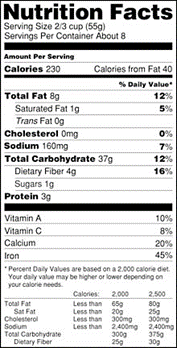 Anyone trying to eat healthily or count calories can relate to the confusing state of nutritional measures. The app I (sometimes) use tracks bread in grams, almonds in ounces, soup in grams, and sometimes ambiguously lists “serving” as the unit of measure. So, if I eat a handful of almonds, 2 slices of bread and a can of soup, did I eat too much? Of course, I can do a quick search and find that 2 slices of bread amount to about 56 grams, 12-13 almonds count as a half of an ounce, and the can of soup is 242 grams. But for something I don’t want to be spending my time on, more required research means it’s not worth the trouble.
Anyone trying to eat healthily or count calories can relate to the confusing state of nutritional measures. The app I (sometimes) use tracks bread in grams, almonds in ounces, soup in grams, and sometimes ambiguously lists “serving” as the unit of measure. So, if I eat a handful of almonds, 2 slices of bread and a can of soup, did I eat too much? Of course, I can do a quick search and find that 2 slices of bread amount to about 56 grams, 12-13 almonds count as a half of an ounce, and the can of soup is 242 grams. But for something I don’t want to be spending my time on, more required research means it’s not worth the trouble.
Units of measurement (which is what’s being counted, such as dollars, number of items, degrees Fahrenheit, seconds, or unit produced, etc.) should be intuitive where possible. Most of us can visualize 12 almonds but not a half ounce.
This principle applies to KPI design in the workplace. Sometimes I will see a client get too clever without an obvious benefit. One client thought it was too pedestrian to simply measure sales dollars, pipeline size, win rate, average deal size, and other common business development measures, so they created a convoluted index that no one really understood. The sales team would meet to discuss the pipeline sales index performance and you could see the confusion and frustration on many of the faces. No one knew where to focus their improvement efforts.
This sometimes happens due to the best of intentions. Web traffic measures don’t always tell you what you want to know and so the web design world has moved towards more sophisticated measurements of “engagement”. While an engagement score (which typically measure how much your website visitors are interacting with your website and online brand) might be more meaningful to an educated audience, there is a risk that the users of the data no longer understand what is being measured.
The key is that the farther you get from the most intuitive unit of measure, the more you must educate people about the measure. For example, the baseball world has evolved away from simply counting home runs and batting average to the more sophisticated ‘sabermetrics’ like Wins Above Replacement (WAR) and Weighted Runs Created (wRC+). For diehards of either baseball or statistical analysis, this movement has been a breath of fresh air that has revolutionized the game. To casual fans, however, these statistics are confusing and off-putting. Home runs and batting average might not be as meaningful, but at least all of us know what we are counting.
If you lead an organization, you must ask yourself if most of your employees will find the more convoluted measures useful enough to justify the additional educational effort needed. If it is a strong measure, it will be an easy decision. The simpler measure might not be good enough – the more complicated solution might really be transformational. But in some cases, you might decide that you simply want your employees to understand that they are trying to hit it over your metaphorical fence and leave it at that. Remember that measurement is not something that everyone wants to spend their time on. Make sure that it is worth the trouble.
If you would like to learn more about our general approach to KPI development, please consider our KPI Professional certification program.
Sources
Image Source: Wikipedia



